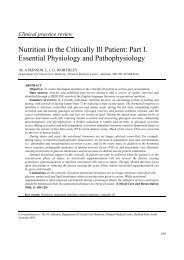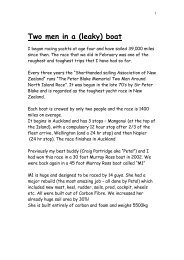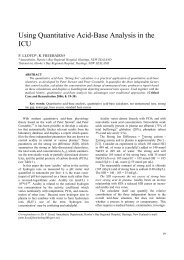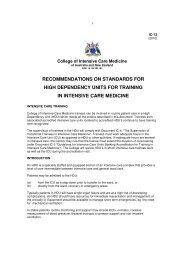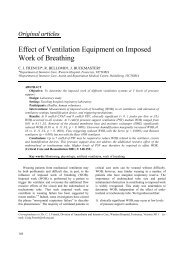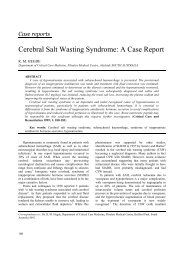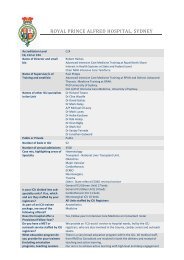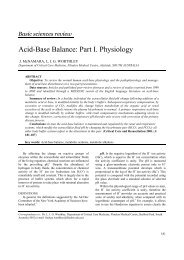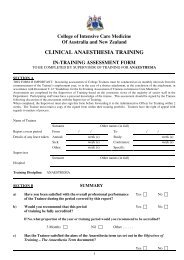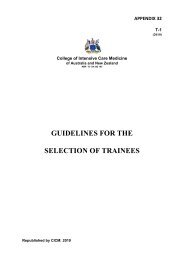to get the file
to get the file
to get the file
You also want an ePaper? Increase the reach of your titles
YUMPU automatically turns print PDFs into web optimized ePapers that Google loves.
Early and Late Removal of <strong>the</strong> Pressure Bandage<br />
in Brown Snake Envenomation: A Report of<br />
Two Cases<br />
D. C. SIMES<br />
Intensive Care Unit, Fremantle Hospital, Fremantle, WESTERN AUSTRALIA<br />
ABSTRACT<br />
Two cases of brown snake envenomation are presented where <strong>the</strong> duration of bandage application in<br />
one patient was prolonged compared with <strong>the</strong> o<strong>the</strong>r patient and was associated with a reduction in <strong>the</strong> <strong>to</strong>tal<br />
amount of antivenom required. One patient had <strong>the</strong> bandage removed 2 hours and twenty minutes after<br />
application and required 25 units of brown snake antivenom <strong>to</strong> neutralise <strong>the</strong> defibrination coagulopathy<br />
and manage an upper gastrointestinal haemorrhage. This patient also sustained an urticarial reaction<br />
during administration of <strong>the</strong> final 5 vials of antivenom. The o<strong>the</strong>r patient had <strong>the</strong> bandage released more<br />
than 22 hours after its application and only required a <strong>to</strong>tal of 6 units of brown snake antivenom <strong>to</strong><br />
neutralise <strong>the</strong> defibrination coagulopathy. In <strong>the</strong> latter case, <strong>the</strong>re was no reaction <strong>to</strong> any of <strong>the</strong> vials of<br />
antivenom<br />
These cases suggest that bandage release could be delayed well beyond <strong>the</strong> usual recommended time <strong>to</strong><br />
effect a reduction in peak and cumulative venom levels and antivenom requirements. (Critical Care and<br />
Resuscitation 2002; 4: 116-118)<br />
Key words: Envenomation, pressure immobilisation, antivenom, coagulopathy<br />
While Australian snakes usually cause only minor<br />
local tissue damage at <strong>the</strong> bite site, envenomation leading<br />
<strong>to</strong> coagulopathy and neuropathy can be life threatening.<br />
This has led <strong>to</strong> <strong>the</strong> recommendation of a pressure<br />
immobilisation technique <strong>to</strong> slow <strong>the</strong> centripetal movement<br />
of venom along lymphatics or low pressure vascular<br />
systems. 1,2<br />
Two cases of brown snake envenomation are<br />
presented, where <strong>the</strong> duration of bandage application in<br />
one was prolonged (> 22 hr) and was associated with a<br />
reduction in <strong>the</strong> <strong>to</strong>tal amount of antivenom required<br />
when compared with <strong>the</strong> o<strong>the</strong>r case where <strong>the</strong> duration<br />
of bandage application was 2 hr 20 minutes. The cases<br />
suggest that bandage release could be delayed well<br />
beyond <strong>the</strong> usual recommended time, 3 <strong>to</strong> effect a reduction<br />
in peak and cumulative venom levels and antivenom<br />
requirements.<br />
CASE REPORTS<br />
Patient 1<br />
A 14 year old insulin-dependent diabetic high school<br />
student was admitted <strong>to</strong> <strong>the</strong> emergency department after<br />
being bitten on <strong>the</strong> big <strong>to</strong>e by a brown snake. Within<br />
fifteen minutes, a firm bandage was applied above <strong>the</strong><br />
bite site and she was transferred <strong>to</strong> <strong>the</strong> local hospital<br />
where she vomited small quantities of bright blood.<br />
On examination she was drowsy and weak. Her<br />
blood pressure was 100/80 mmHg, pulse 150 beats per<br />
minute and pulse oximetry revealed a saturation of 91%<br />
breathing air. A rash was visible around <strong>the</strong> bite site and<br />
up <strong>to</strong> <strong>the</strong> ankle.<br />
A venom-detection kit at <strong>the</strong> peripheral hospital<br />
recorded a positive result for brown snake venom, so<br />
she received one vial of brown snake specific antivenom<br />
prior <strong>to</strong> transfer <strong>to</strong> our hospital. A second venom<br />
Correspondence <strong>to</strong>: Dr. D. C. Simes, Intensive Care Unit, Fremantle Hospital, Fremantle, Western Australia 6160 (email:<br />
david.simes@health.wa.gov.au)<br />
116
Critical Care and Resuscitation 2002; 4: 116-118 D. C. SIMES<br />
detection kit analysis confirmed brown snake venom at<br />
<strong>the</strong> bite site. During <strong>the</strong> administration of a second vial<br />
of brown snake antivenom <strong>the</strong> bandage was removed.<br />
This occurred 2 hours and twenty minutes after <strong>the</strong><br />
envenomation. Intravenous hydrocortisone (100 mg 6hourly)<br />
was administered with <strong>the</strong> intention of reducing<br />
<strong>the</strong> incidence of serum sickness.<br />
At this stage a coagulopathy was documented, with<br />
<strong>the</strong> plasma fibrinogen level being unrecordable. The<br />
blood was also unclottable for 6 hours following <strong>the</strong><br />
envenomation and for 4 hours after <strong>the</strong> bandage removal.<br />
After 25 vials of brown snake specific antivenom, 2<br />
units of fresh frozen plasma and 8 units of cryoprecipitate,<br />
<strong>the</strong> plasma fibrinogen, APTT and INR levels<br />
were able <strong>to</strong> be measured (plasma fibrinogen level was<br />
0.5 g/L and <strong>the</strong> APTT and INR were less than 200 s and<br />
10, respectively). However, during <strong>the</strong> administration of<br />
<strong>the</strong> final 5 vials of antivenom, <strong>the</strong> patient experienced<br />
facial and distal upper limb swelling and a rash. She was<br />
given subcutaneous adrenaline (1 mg) and oral<br />
promethazine (25 mg) which over <strong>the</strong> next 24 hours<br />
settled <strong>the</strong> facial and limb oedema.<br />
She returned home less than 48 hours after her<br />
severe envenomation, having experienced minimal local<br />
tissue injury, no rhabdomyolysis or renal dysfunction,<br />
and with a normal coagulation pro<strong>file</strong>.<br />
Patient 2<br />
A 50 year old man with no past his<strong>to</strong>ry of renal,<br />
cardiac or respira<strong>to</strong>ry disease was bitten on his left<br />
middle <strong>to</strong>e while walking barefoot in his property. A<br />
“three foot long” brown snake was seen sli<strong>the</strong>ring away<br />
after he became aware of discomfort in his foot. He<br />
washed his foot before returning <strong>to</strong> his house where he<br />
collapsed after complaining of a headache and feeling<br />
“queer”. His wife applied a firm bandage over his left<br />
lower leg within 15 minutes of being bitten.<br />
He was admitted <strong>to</strong> our hospital oriented and alert.<br />
His blood pressure was 120/70 mmHg, pulse was 120<br />
beats per minute and pulse oximetry revealed a saturation<br />
of 94% breathing air. There was local bruising at <strong>the</strong><br />
bite site and a venom detection kit which assessed fluid<br />
at <strong>the</strong> bite site was strongly positive for brown snake<br />
venom.<br />
While he had no clinically apparent bleeding, within<br />
two hours of <strong>the</strong> bite his fibrinogen had fallen <strong>to</strong> less<br />
than 1 gm/L, and, along with <strong>the</strong> APTT and INR, was<br />
unrecordable three hours later. His D-dimer recording at<br />
this stage was elevated <strong>to</strong> greater than 3.2 mg/L (normal<br />
range < 0.1 mg/L).<br />
He was given hydrocortisone (100 mg i.v) and<br />
promethazine (25 mg orally) prior <strong>to</strong> <strong>the</strong> first dose of<br />
brown snake antivenom. To control <strong>the</strong> coagulopathy he<br />
received 5 vials of antivenom, which was followed by 8<br />
units of cryoprecipitate and 2 units of fresh frozen<br />
plasma.<br />
He developed oliguric renal dysfunction (plasma<br />
creatinine peaked at 119 umol/L) and pulmonary<br />
oedema. The latter required CPAP for 4 hours and was<br />
most likely due <strong>to</strong> excess intravenous fluid. He had no<br />
evidence of rhabdomyolysis (plasma creatinine kinase<br />
peaked at 119 U/L) or ECG changes of myocardial<br />
ischaemia. The renal dysfunction was attributed <strong>to</strong> a<br />
combination of dehydration, vasodilatation and direct<br />
nephro<strong>to</strong>xicity of brown snake envenomation.<br />
The bandage was left in place for a <strong>to</strong>tal of 23 hours<br />
after <strong>the</strong> bite, and was removed during <strong>the</strong> infusion of<br />
<strong>the</strong> sixth vial of brown snake antivenom. He suffered no<br />
return of his symp<strong>to</strong>ms of envenomation and was<br />
discharged home <strong>the</strong> following morning after a normal<br />
coagulation pro<strong>file</strong> had been recorded.<br />
DISCUSSION<br />
The divergent clinical course and antivenom<br />
requirements (Figure 1) of <strong>the</strong>se two patients appear <strong>to</strong><br />
be influenced by <strong>the</strong> timing of <strong>the</strong> bandage release,<br />
altering <strong>the</strong> rate at which venom reached <strong>the</strong> circula<strong>to</strong>ry<br />
system <strong>to</strong> affect coagulation. The time taken <strong>to</strong> apply <strong>the</strong><br />
bandage after <strong>the</strong> bite was approximately 15 minutes in<br />
both cases, whereas <strong>the</strong> removal of <strong>the</strong> bandage was<br />
early (i.e. 2.3 hours) in <strong>the</strong> first case and late (i.e. 23<br />
hours) in <strong>the</strong> second case.<br />
It is generally accepted that if application of a broadbased<br />
firm bandage is effective in reducing peak venom<br />
levels, 2,4 <strong>the</strong>n it should be left on until <strong>the</strong> antivenom is<br />
immediately available. 3 However, it would seem logical<br />
<strong>to</strong> leave <strong>the</strong> low pressure bandage on for a sustained<br />
period, as <strong>the</strong>re may be an advantage in having a slow<br />
“lymphatic seep” ra<strong>the</strong>r than rapid release of <strong>the</strong> venom<br />
in<strong>to</strong> <strong>the</strong> circulation.<br />
Australia is unique in having a high proportion of<br />
venomous snakes that do not produce significant local<br />
tissue damage that may be exacerbated by a pressure<br />
bandage that causes venous congestion or increased<br />
local concentration of venom. Any problems of prolonged<br />
bandage application <strong>the</strong>n amount <strong>to</strong> inconvenience<br />
ra<strong>the</strong>r than potential local tissue injury.<br />
Fur<strong>the</strong>rmore, <strong>the</strong> cumulative amount and not just <strong>the</strong><br />
rate of envenomation may be reduced by prolonged<br />
bandage application. It is not clear how much of <strong>the</strong><br />
venom becomes denatured by temperature and proteolytic<br />
enzymes while residing in human tissues with a<br />
bandage impeding its centripetal progress, but <strong>the</strong>re is a<br />
demonstrable reduction in coagulopathy-inducing proteins.<br />
5<br />
An argument can be made that <strong>the</strong> <strong>to</strong>urniquet should<br />
117
D. C. SIMES Critical Care and Resuscitation 2002; 4: 116-118<br />
Figure. 1. The antivenom requirements and time of administration following <strong>the</strong> envenomation<br />
remain in place much longer than is <strong>the</strong> usual practice,<br />
with <strong>the</strong> hope that denaturation of <strong>the</strong> <strong>to</strong>xic components<br />
will occur <strong>to</strong> a greater degree, and that <strong>the</strong> coagulopathic<br />
and neuro<strong>to</strong>xic effects can thus be attenuated<br />
without <strong>the</strong> administration of an unnecessarily large<br />
amount of horse serum-based antivenom, with its<br />
attendant risks.<br />
Received: 27 December 2001<br />
Accepted: 18 April 2002<br />
REFERENCES<br />
1. Su<strong>the</strong>rland SK, Coulter AR, Harris RD, Lovering KE,<br />
Roberts ID. A study of <strong>the</strong> major Australian snake<br />
venoms in <strong>the</strong> monkey (macaca fascicularis). I. The<br />
118<br />
movement of injected venoms, methods which retard<br />
this movement, and <strong>the</strong> responses <strong>to</strong> antivenoms.<br />
Pathology 1981;13:13-27.<br />
2. Su<strong>the</strong>rland SK, Coulter AR, Harris RD. Rationalisation<br />
of first aid measures for elapid snakebite. Lancet<br />
1979;1:183-185.<br />
3. Su<strong>the</strong>rland SK. When do you remove first aid measures<br />
from an envenomed limb? Med J Aust. 1981;1:542-544.<br />
4. Anker RL,Straffon WG, Loiselle DS, Anker KM.<br />
Snakebite:comparison of three methods designed <strong>to</strong><br />
delay uptake of “mock venom”. Aust Fam Physician<br />
1983;12:365-368.<br />
5. Su<strong>the</strong>rland SK., Campbell DG, Stubbs AE. A study of<br />
<strong>the</strong> major Australian snake venoms in <strong>the</strong> monkey<br />
(macaca fascicularis). II Myolytic and haema<strong>to</strong>logic<br />
effects of venoms. Pathology 1981;13:705-715.



